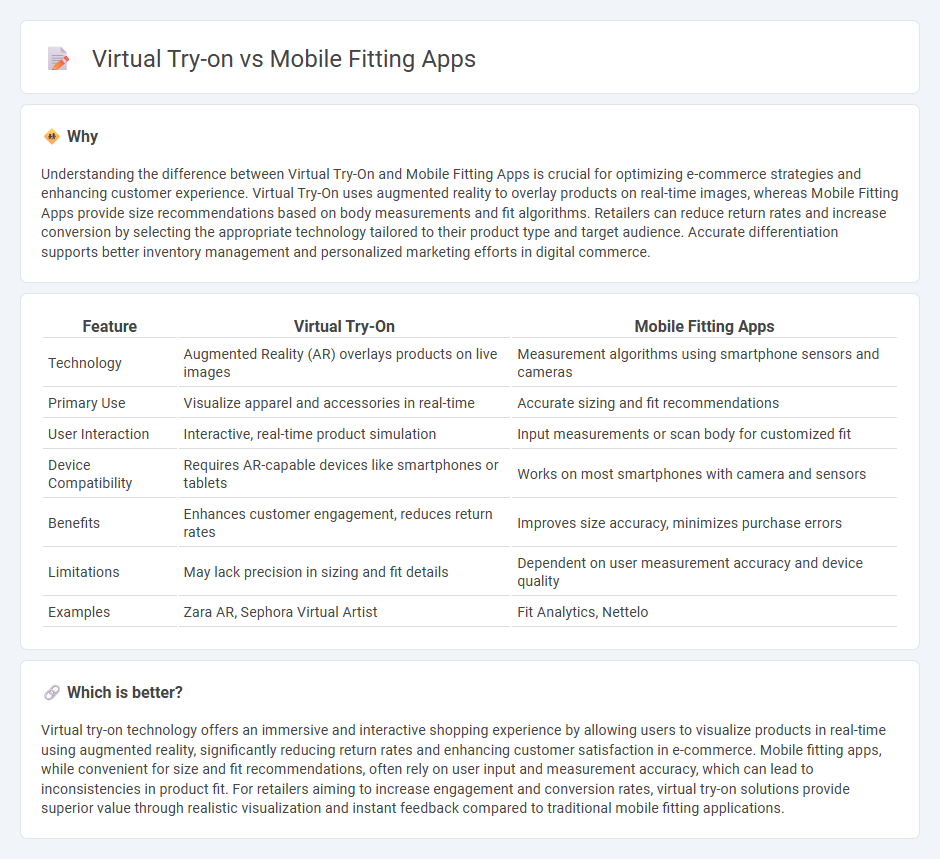
Virtual try-on technology revolutionizes online shopping by allowing customers to preview products like clothing, eyewear, or makeup in real-time using augmented reality, enhancing confidence and reducing returns. Mobile fitting apps complement this by providing personalized measurements and style recommendations based on user data, offering a tailored shopping experience. Explore the latest advancements in these innovative commerce solutions to transform your retail journey.
Why it is important
Understanding the difference between Virtual Try-On and Mobile Fitting Apps is crucial for optimizing e-commerce strategies and enhancing customer experience. Virtual Try-On uses augmented reality to overlay products on real-time images, whereas Mobile Fitting Apps provide size recommendations based on body measurements and fit algorithms. Retailers can reduce return rates and increase conversion by selecting the appropriate technology tailored to their product type and target audience. Accurate differentiation supports better inventory management and personalized marketing efforts in digital commerce.
Comparison Table
| Feature | Virtual Try-On | Mobile Fitting Apps |
|---|---|---|
| Technology | Augmented Reality (AR) overlays products on live images | Measurement algorithms using smartphone sensors and cameras |
| Primary Use | Visualize apparel and accessories in real-time | Accurate sizing and fit recommendations |
| User Interaction | Interactive, real-time product simulation | Input measurements or scan body for customized fit |
| Device Compatibility | Requires AR-capable devices like smartphones or tablets | Works on most smartphones with camera and sensors |
| Benefits | Enhances customer engagement, reduces return rates | Improves size accuracy, minimizes purchase errors |
| Limitations | May lack precision in sizing and fit details | Dependent on user measurement accuracy and device quality |
| Examples | Zara AR, Sephora Virtual Artist | Fit Analytics, Nettelo |
Which is better?
Virtual try-on technology offers an immersive and interactive shopping experience by allowing users to visualize products in real-time using augmented reality, significantly reducing return rates and enhancing customer satisfaction in e-commerce. Mobile fitting apps, while convenient for size and fit recommendations, often rely on user input and measurement accuracy, which can lead to inconsistencies in product fit. For retailers aiming to increase engagement and conversion rates, virtual try-on solutions provide superior value through realistic visualization and instant feedback compared to traditional mobile fitting applications.
Connection
Virtual try-on and mobile fitting apps revolutionize commerce by enhancing online shopping experiences through augmented reality and AI technology. These tools increase customer engagement and conversion rates by allowing shoppers to visualize products like clothing, accessories, or eyewear in real-time on their digital avatars or live images. Retailers benefit from reduced return rates and improved customer satisfaction by bridging the gap between virtual and physical shopping environments.
Key Terms
Augmented Reality (AR)
Mobile fitting apps leverage advanced Augmented Reality (AR) technology to provide real-time, interactive garment visualization on users' bodies, enhancing online shopping experiences by reducing returns and increasing confidence in purchases. Virtual try-on platforms utilize AR to superimpose clothing or accessories onto live images or videos, offering precise fit and style previews through computer vision and machine learning algorithms. Explore further to discover how AR continues to revolutionize personalized fashion retail and customer engagement.
Size Recommendation Algorithms
Size recommendation algorithms in mobile fitting apps analyze user body measurements and purchase history using machine learning to provide personalized size suggestions, reducing fit-related returns by up to 30%. Virtual try-on technologies integrate 3D body scanning and augmented reality to simulate garment fit visually, enhancing user confidence but often less accurate in size prediction compared to dedicated algorithms. Discover how these technologies revolutionize online shopping by optimizing fit and reducing returns.
3D Body Scanning
Mobile fitting apps utilize 3D body scanning technology to create accurate digital avatars that enhance personalized clothing recommendations and size precision. Virtual try-on platforms leverage these 3D models to simulate realistic garment draping and movement, improving user confidence in online purchases. Explore how 3D body scanning revolutionizes the intersection of mobile fitting apps and virtual try-on experiences.
Source and External Links
Top 7 Virtual Dressing Room Apps - Wondershare Virbo - Lists popular virtual fitting apps like Style.Me and Virtual Dressing Room, which allow users to try on clothes virtually via avatars and AI-based body mapping for accurate size-fit recommendations on smartphones.
Fit Freedom - 7T, Inc. - Describes Fit Freedom, a mobile AR app that creates exact 3D digital body models using smartphone cameras for precise clothing measurements and improved fit without guesswork.
MobileFitting - APK Download for Android | Aptoide - An app designed for hearing care professionals to set up and adjust Signia hearing aids with mobile devices, streamlining fitting processes rather than clothing fitting.
 dowidth.com
dowidth.com